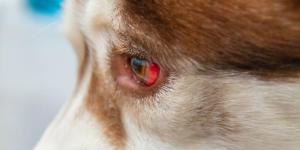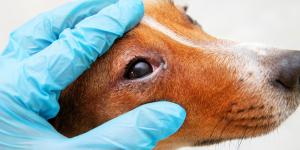My Dog's Eyes Are Twitching - Nystagmus in Dogs



See files for Dogs
Our dog's eyes can be very expressive, but also capricious. Sometimes they look directly at us and follow us around the room. Other times they might seem to avoid eye contact in a coy way. When they see something which interests them such as a potential plaything, their eyes can dart back and forth in search of it. Rapid eye movement when the dog's head is in motion or they focus on something which is moving is normal as it allows them to stabilize images in the retina and maintain balance. When a dog's eyes are twitching rapidly while their head is stationary, it is known as nystagmus. The eye movements can be horizontal, vertical, and rotational, but are usually involuntary.
At AnimalWised, we better understand why my dog's eyes are twitching by looking at nystagmus in dogs. In most cases, the causes of nystagmus in dogs will result in other concurrent symptoms which can help us to diagnose the underlying problem. It is this underlying problem at which treatment will be directed.
What is nystagmus in dogs?
Nystagmus is defined as involuntary rhythmic oscillations of the eyes which looks like they are twitching. However, it is important to note there are two main types of nystagmus in dogs:
- Physiological nystagmus: non-pathological form which occurs as a reflex when the eyes try to stabilize their gaze when the head moves. When the head moves to one side, it stimulates cilia in the vestibular receptors, causing the eyes to move slowly in one direction, followed by rapid movement in the opposite direction.
- Pathological nystagmus: also an involuntary movement of the eyeball in both slow and fast motions. In this case, it is due to a physiological condition which results in the eyes moving in different directions and at different speeds when at rest. These issues are often related to vestibular disorders in the dog, but it can also be due to neurological problems or other health factors.
The movement of the eyes is not always the same, but it does have rapid and slow phases. The rapid phase occurs when tension in the extraocular muscles reaches its limit, causing corrective eye movement in the direction of head movement. This movement occurs due to the gaze fixing on one point for a brief moment before quickly settling on the new position. The slow phase of this reflex involves vestibular receptors in the membranous labyrinth and the fast phase involves vestibular nuclei in the brainstem[1].
Nystagmus movement of the eyes can go in a rotational, vertical or horizontal direction. Moving side to side is the most common movement in dogs. The direction of the nystagmus is typically defined by the direction of the fast phase, indicating the side of the vestibular lesion. The movement can be modified by changing the position of the head. It is very common to see the dog tilt their head when their eyes are twitching back and forth.
When there is damage to one side of the vestibular system due to a pathology, an imbalance in the neural activity of the vestibular nuclei occurs. This is because the vestibular system on the normal side continues to supply constant input to the vestibular nuclei. This imbalance is interpreted by the brain stem as a rotation or movement of the body, causing the eys to twitch even if the head is still. Vertical nystagmus identifies the disease as originating from the central nervous system[2].
Symptoms of nystagmus in dogs
Nystagmus is a symptom, not a disease in itself. This manifestation of dog's eyes twitching and darting may indicate a disease of the vestibular system. When the animal's head is in its normal position, the eyes show rapid movements which can be horizontal, vertical or rotational. Rapid eye movement when the dog is awake is a sign of a problem, but it is important to note that twitching is often normal when the dog is in deep sleep.
Vestibular syndrome in dogs is a set of symptoms which occur when there is damage to the vestibular system, i.e. the sensory system which helps to maintain balance and spatial orientation. While other systems are involved, especially the musculoskeletal system, the vestibular system helps to maintain the head position, as well as the position of the eyes, neck, body and extremities in relation to the head[1].
These vestibular disorders are common in dogs and can lead to symptoms such as pathological nystagmus, positional strabismus, head tilt, whirling, paresis (partial loss of movement) and ataxia in dogs (difficulty or inability to maintain motor coordination). Animals with acute disease may also present vomiting associated with the imbalance. These symptoms are common to central and peripheral vestibular syndrome[2].

Causes of Nystagmus in Dogs
Although nystagmus is associated with the vestibular system, there are many underlying reasons why this system is affected. They include:
- congenital anomalies: hereditary problems occur sporadically in purebred litters, although it is more common in cats than dogs. Onset of vestibular disorders usually occur any time from birth until the animal reaches a few weeks of age. For example, deafness may accompany vestibular signs such as head tilting, ataxia and the dog walking around in circles. It may be unilateral or bilateral.
- Hypothyroidism: hypothyroidism in dogs is a malfunctioning of the thyroid gland which results in a reduction of hormone production. It can have acute or chronic signs, including lethargy, generalized weakness, weight loss and poor coat quality. Vestibular signs including nystagmus can occur without these other symptoms, but it will depend on the severity of the condition.
- Otitis media/interna: otitis is the most common cause of peripheral canine vestibular syndrome. By extension, this means it is one of the main causes of nystagmus in dogs. An infection of the ar which originates in the external auditory canal, it is caused mainly by bacteria. Fungal infections can occur. Inflammation and redness of the dog's ear occurs which may be hot to the touch.
- Idiopathic vestibular syndrome: a set of clinical signs of acute onset which have no established causes. It normally manifests in dogs older than 5 years, with an average age of between 12 and 13 years. Nystagmus symptoms may be preceded by nausea and vomiting.
- Nasopharyngeal polyps: nasopharyngeal polyps are composed of vascularized fibrous tissue lined by epithelium and are more common in cats than dogs. They can originate in the tympanic cavity or in the Eustachian tube. They grow progressively, occupying the nasopharynx and reaching the middle ear until eye twitching can be observed once sufficiently progressed.
- Ototoxicity: certain drugs can cause ototoxicity, i.e. vestibular or hearing mal function as a result of medications. Toxicity can occur with topical or systemic administration. Aminoglycoside antibiotics are the agents that most cause ototoxicity.
- Neoplasms: the most common tumors that have vestibular syndrome as secondary symptoms are tumors of the auricle, external auditory canal and inner ear. This is because they compress of infiltrate the bony labyrinth or nervous components. Fibrosarcomas, chondrosarcomas, osteosarcomas and others can destroy structures in the inner ear. Ceruminous gland adenocarcinomas, sebaceous gland adenocarcinomas, carcinomas of unknown origin and squamous cell carcinomas are the most common ear tumors.
- Trauma: physical trauma to the middle or inner ear can cause peripheral vestibular signs, such as excoriations and swelling on the face and bleeding in the ear canal on the affected side. Nystagmus in dogs can also result.
Treatment of nystagmus in dogs
If the nystagmus is physiological, you do not have to worry or treat it. It will be normal and resolve itself naturally. If the nystagmus is pathological or we are unsure if it is physiological, the dog needs to be taken to the veterinary center for a neurological examination. The earlier the problem is diagnosed, the greater the chances of successful treatment.
Treatment of nystagmus in dogs should be directed at the underlying cause. There are diseases of the central nervous system that specifically affect the vestibular pathways. In addition, any pathology that develops in the adjacent regions can secondarily lead to vestibular dysfunction due to ischemia (decreased or interrupted blood supply), compression or infiltration.
As nystagmus in dogs is not a pathology, but a symptom that alerts us that something is wrong, only a qualified veterinarian should be tasked with determining the underlying cause. If you see your dog's eyes are twitching from side to side without apparent reason, it is essential to go to a professional as soon as possible.
This article is purely informative. AnimalWised does not have the authority to prescribe any veterinary treatment or create a diagnosis. We invite you to take your pet to the veterinarian if they are suffering from any condition or pain.
If you want to read similar articles to My Dog's Eyes Are Twitching - Nystagmus in Dogs, we recommend you visit our Eye problems category.
1. Antunes, J.R. (2016). Peripheral vestibular syndrome in cats. Federal University of Rio Grande do Sul, Faculty of Veterinary Medicine. Retrieved from: https://lume.ufrgs.br/bitstream/handle/10183/148181/001000739.pdf?sequence=1&isAllowed=y. Accessed 10/13/2022
2. Diogo, C. C., Camassa, J. A. A. (2015). Bacterial central vestibular syndrome in dogs: review of the literature. Scientific Journal of Veterinary Medicine. Retrieved from: http://faef.revista.inf.br/imagens_arquivos/arquivos_destaque/CB81tdSKMD2qK1h_2015-11-27-12-18-8.pdf. Accessed 10/13/2022
- Moraes, I. (2022). Nystagmus: understanding what this dysfunction is that can affect animals . Bug life. Retrieved from: https://revistacasaejardim.globo.com/Vida-de-Bicho/Saude/noticia/2022/05/nistagmo-entenda-qual-e-esta-disfuncao-que-pode-afetar-os-animales.html
- Baldini, J. D. A., et al. (2021). Geriatric vestibular syndrome in canines. XIX Interinstitutional Cultural Scientific Meeting. Retrieved from: https://www2.fag.edu.br/coopex/inscricao/arquivos/ecci_2021/13-10-2021--14-39-34.pdf






